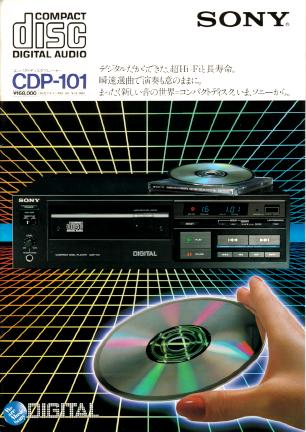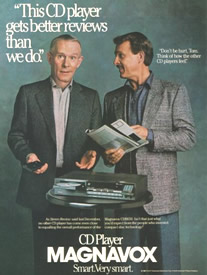 The LP lived on, but in the mass market, both the LP and the cassette were pushed aside by the Compact Disc. The Phillips company, which had earlier introduced the cassette, had developed a laser disc for video recording in the late 1970s. Phillips teamed up with Sony, which had developed a digital tape recorder for making “master” recordings at about the same time. The new disks were created by re-recording ordinary studio tapes onto the digital tape, then using the digital tape to burn laser discs. A copy of the master laser disc was then used to press plastic duplicates, which were coated with shiny aluminum, encased in protective layers, and packaged for sale. Unlike the LP or the original Phillips video laser discs, which were quite large, the audio-only laser discs were “compact,” and hence the name Compact Disc.
The LP lived on, but in the mass market, both the LP and the cassette were pushed aside by the Compact Disc. The Phillips company, which had earlier introduced the cassette, had developed a laser disc for video recording in the late 1970s. Phillips teamed up with Sony, which had developed a digital tape recorder for making “master” recordings at about the same time. The new disks were created by re-recording ordinary studio tapes onto the digital tape, then using the digital tape to burn laser discs. A copy of the master laser disc was then used to press plastic duplicates, which were coated with shiny aluminum, encased in protective layers, and packaged for sale. Unlike the LP or the original Phillips video laser discs, which were quite large, the audio-only laser discs were “compact,” and hence the name Compact Disc.
The CD was introduced to the public in 1982. Partly because of the high initial cost (a player cost over $2000, and the discs themselves cost $12-16), sales were limited. By about 1985, however, it was possible to buy a player for $350 or less, and prices were around $150 a few years later. Many consumers resented being pressured to abandon the collections of LP records they had accumulated over the years. However, the CD eventually won over the hearts of most consumers.
Sony also became a record company in the 1980s through the purchase of CBS Records (formerly Columbia). Sony followed this up in 1989 with the purchase of Columbia Pictures Entertainment.
In the studio, digital technology was making an important impact. Where the role of digital recorders was initially quite limited, soon it became easy and relatively inexpensive to use digital devices to compose, perform, record, edit, and mix songs. Previously, musical instruments had been separate from recording machines, and both had been separate from computers, but new technologies combined all three. Where tape recorders had made it possible for individual musicians to play multiple instruments or record multiple vocal parts, or even become “one man bands,” digital technology accelerated the tendency to do so. Many “bands” were really just one or two people manipulating drum machines and synthesizers, or re-recording bits and pieces of existing music.
 If digital recording was a success in the studio, it was initially a failure as a consumer technology. The first consumer digital recorders were introduced in the late 1970s. They were essentially modified Betamax VCRs, and the cost was quite high. Digital recording re-appeared in 1990 with the introduction of Digital Audio Tape, and later with the Digital Compact Cassette, and again with the Sony Minidisc. Opposed by a recording industry fearful of music piracy, these formats failed to appeal to consumers.
If digital recording was a success in the studio, it was initially a failure as a consumer technology. The first consumer digital recorders were introduced in the late 1970s. They were essentially modified Betamax VCRs, and the cost was quite high. Digital recording re-appeared in 1990 with the introduction of Digital Audio Tape, and later with the Digital Compact Cassette, and again with the Sony Minidisc. Opposed by a recording industry fearful of music piracy, these formats failed to appeal to consumers.
Through the end of the 1990s, it appeared that the next home recording medium would undoubtedly be a recordable form of CD. It took many years for these to be introduced, and many more years for them to come down in price. Only in the early years of the 21st century did the price of a CD burner and the blank disks compete with a cassette deck.
By that time, however, the whole idea of storing sound on physical “records” was being called into question. Home computer users began sharing digitized music in a number of different formats in the late 1990s. The MP3 standard began to catch on, and Napster software appeared to make it possible for users to access each other’s songs via the World Wide Web. The recording industry freaked and shut down Napster, but the appeal of Internet-distributed music remained.
- Previous: Portable Music
- Next: Building the American Dictating Machine Industry